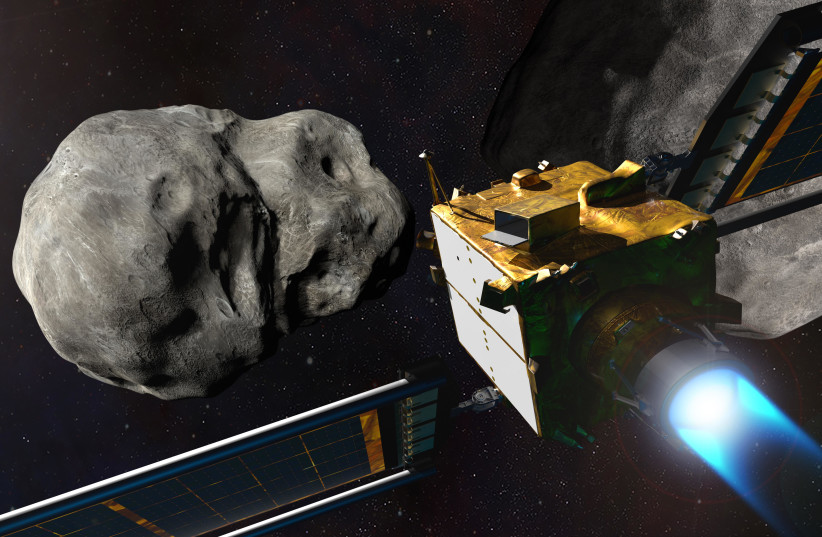An asteroid the size of 48 eggplants is set to pass by the Earth on Tuesday, April 25, just ahead of Israeli Independence Day, according to NASA's asteroid tracker.
The asteroid in question was designated 2023 HF4, having been discovered this year, according to the Center for Near-Earth Object Studies (CNEOS) at NASA's Jet Propulsion Laboratory (JPL).
Although, it is just one of five asteroids set to pass by the planet on Tuesday, 2023 HF4 will be coming much closer than any of the others.
Its arrival also coincides with Israel's Remembrance Day and just before Independence Day.
How big is the asteroid coming toward Earth in 2023?
Asteroid 2023 HF4 is rather small as far as asteroids go, being estimated by NASA JPL to be around 12 meters in diameter at most.

To put that in perspective, consider the eggplant. Also known as an aubergine, this vegetable is a staple of Israeli cuisine, being found in everything from salads to street food sandwiches like falafel and shawarma. And, of course, it is one of the main ingredients in sabich.
That aside, according to the University of California, Davis, the average eggplant grows to around 10 inches, or 25 centimeters in size.
By those calculations, asteroid 2023 HF4 is the size of 48 eggplants lined up.
What other asteroids are set to pass by soon?
As previously stated, asteroid 2023 HF4 is just one of five asteroids set to come on April 25.
Here are the others, along with their own size comparisons:
- Asteroid 2023 HL2, with an estimated diameter of 47 meters, or just under 31 king salmon lined up in a row
- Asteroid 2023 HW2, with an estimated diameter of 48 meters, or around 26 average-height Dutch men lined up from head to toe
- Asteroid 2023 GO1, with an estimated diameter of 31 meters, or around 124 and a half Louis Vuitton Speedy 25 handbags
- Asteroid 2023 HH3, with an estimated diameter of 23 meters, or around 50 large cardboard boxes stacked by length
Is an asteroid going to hit the Earth in 2023?
Well, technically yes, because it already happened.
One instance even happened in Israel fairly recently, when a meteor exploded in the northeast, creating a fireball visible even in the center of the country.
Several months earlier, a meteor the size of a Pembroke Welsh corgi that weighed as much as four baby elephants crashed into Texas.
Even earlier, several larger objects which are designated asteroids have also hit the Earth, such as the half-a-giraffe-sized 2022 EB5 that impacted near Iceland and the two-Super-Bowl-trophy-sized 2023 CX1 that impacted near Normandy.
Note that none of these asteroids actually caused any damage to the Earth. There is a good reason for that: They were so small that they ended up exploding in the atmosphere and burning up, with any remnants being too small to cause harm.
While this can't be said for all the asteroids passing the Earth on Tuesday – some of the larger ones like asteroid 2023 HW2 could possibly be able to cause some damage by surviving the trip – it certainly is the case for asteroid 2023 HF4.
Luckily, 2023 HF4 is the only one coming even remotely close enough to be cause for concern.
According to the CNEOS data, asteroid 2023 HF4 is set to pass by at a distance of around 500,000 kilometers. That's much closer than the usual distance asteroids pass the Earth.
However, it's not close enough. The Moon orbits the Earth at an average distance of 384,000 kilometers, which is much closer.

Do we have any way to stop an asteroid from hitting the Earth?
Of course, we do – at least, we do know.
Just as Israel worked hard throughout its years of existence to find ways to defend itself from rockets and eventually succeeded with the Iron Dome, so too have scientists in the field of planetary defense working to defend us from asteroids.
The most promising result of this research is NASA's Double Asteroid Redirection Test (DART) Mission, which managed to help change the orbit of the faraway asteroid Dimorphous by crashing into it.
Scientists now know for sure that with enough time and planning, we can safeguard the Earth from an asteroid impact – even ones measured using the eggplant metric.
